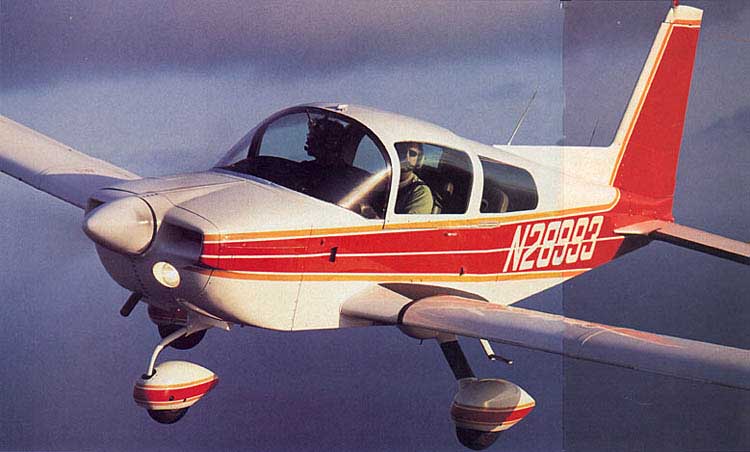
|
The first time you climb into a Tiger you'll notice that it's just different. The sliding canopy offers either easy or difficult access, depending upon your agility level. Standard practice is to throw a leg over the cabin sidewall and flick back the seat cushion with the toe of your foot. Step down onto the spar carry-through with that foot and then drag the other one inside. If it's raining, you'll get wet. You'll settle into a cabin that's comparatively spacious and airy. Move the controls and you'll notice the telltales of pushrod and torque-tube actuation for the ailerons; the controls are pleasantly solid. Kick the rudder and you'll also be reminded that there's no direct nosewheel steering; the brakes are all you've got. Taxiing a Tiger is not difficult with some practice, although with a strong crosswind blowing you'll want to be confident of the yuality or your brake maintenance. The Tiger's rudder is more effective than that of the smaller AA-1, so differential braking during the takeoff roll is almost unnecessary. Once up and flying, the Tiger delights. It's got light and smooth control forces, reasonably well balanced anlong the axes. Come over from a Cessna 172 or a Piper Warrior and vou'll be plensantly surprised, particularly with the control authoritve in roll. Tigers induce few nosebleeds in the climb, with 750 fpm typical at mid weights. Maintaining the proper airspeed is a must to eke the best climb performance, though; stick to 90 kt or you'll sacrifice quite a lot. |
detail makes the Tiger so swift. |
Although the Tiger and its AA-series siblings are overrepresented in landing accidents, there's really nothing difficult about getting an AA-5 on the ground. Adherence to the proper approach speed is important-72 kt should do it-because the flaps aren't as effective as, say, a Cessna Skyhawk's, so you have less variable drag to help you salvage a high, fast approach. And given that the Tiger's nosewheel steering comes just from brakes and rudder, you'll have to practice the rudder-pedal/toe-brake dance to perfect the transition from steering with the tail to steering with the brakes. True to its simple self, the Tiger has few critical prepurchase inspection areas. Bond-line separation on the control surfaces-except the ailerons-is an ever-diminishing issue but still demands attention. The Tiger makes extensive use of bonded aluminum, and time has shown that the trailing edges of the flaps, rudder, and elevators are the places most likely to experience a debonding of the skin frorn its support structure. Another item demanding attention is the nosewheel torque-tube support. There are four sockets that carry the nosewheel structure into the cabin. You can bounce the nose gently and listen for a clicking sound; that's one indication that further inspection is needed. Fixing a loose torque-tube bond is about a $2,000 proposition. |
|
This rather fast best-rate climb speed points to the small wing; at just 140 square feet, it's smaller than a Skyhawk's by some 30 square feet. The Tiger is much less forgiving of poor pilot technique than is the aforementioned Skyhawk or Warrior. Push the nose over at cruise altitude and be prepared to wave so long to simple Cessnas and Pipers. On the same horsepower, the Tiger is nearly 20 kt faster than a Piper Archer and can even hold its own against the retractable-gear Arrow. What's more, with 51 gallons of usable fuel, the Tiger has decent legs; figure on about 9.5 gph in cruise for a reasonable 4.3 hours' endurance. You'll need to push the little Lycoming to fairly high revs at altitude to get best performance, resulting in a fairly noisy cabin; all that glass contributes also to a cockpit that requires use of headsets. Thanks to the Tiger's slightly higher wing loading-it's a couple of pounds per square inch greater than your typical Cessna or Piper-it handles turbulence well for a 2,400-pound max-gross airplane. Its sharp control reflexes also help keep it on an even keel in choppy air. |
WITH CLAWS STILL SHARP • Marc E. Cook • Photography by Mike Fizer • AOPA PILOT • MAY 1999
Home | Page 1 | Page 2 | Page 3 | Page 4 | Page 5